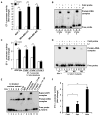Lactoferrin-endothelin-1 axis contributes to the development and invasiveness of triple-negative breast cancer phenotypes
- PMID: 22006997
- PMCID: PMC3617573
- DOI: 10.1158/0008-5472.CAN-11-1143
Lactoferrin-endothelin-1 axis contributes to the development and invasiveness of triple-negative breast cancer phenotypes
Abstract
Triple-negative breast cancer (TNBC) is characterized by the lack of expression of estrogen receptor-α (ER-α), progesterone receptor (PR), and human epidermal growth factor receptor-2 (HER-2). However, pathways responsible for downregulation of therapeutic receptors, as well as subsequent aggressiveness, remain unknown. In this study, we discovered that lactoferrin (Lf) efficiently downregulates levels of ER-α, PR, and HER-2 in a proteasome-dependent manner in breast cancer cells, and it accounts for the loss of responsiveness to ER- or HER-2-targeted therapies. Furthermore, we found that lactoferrin increases migration and invasiveness of both non-TNBC and TNBC cell lines. We discovered that lactoferrin directly stimulates the transcription of endothelin-1 (ET-1), a secreted proinvasive polypeptide that acts through a specific receptor, ET(A)R, leading to secretion of the bioactive ET-1 peptide. Interestingly, a therapeutic ET-1 receptor-antagonist blocked lactoferrin-dependent motility and invasiveness of breast cancer cells. The physiologic significance of this newly discovered Lf-ET-1 axis in the manifestation of TNBC phenotypes is revealed by elevated plasma and tissue lactoferrin and ET-1 levels in patients with TNBC compared with those in ER(+) cases. These findings describe the first physiologically relevant polypeptide as a functional determinant in downregulating all three therapeutic receptors in breast cancer, which uses another secreted ET-1 system to confer invasiveness. Results presented in this article provide proof-of-principle evidence in support of the therapeutic effectiveness of ET-1 receptor antagonist to completely block the lactoferrin-induced motility and invasiveness of the TNBC as well as non-TNBC cells, and thus, open a remarkable opportunity to treat TNBC by targeting the Lf-ET-1 axis using an approved developmental drug.
Figures







Similar articles
-
MEL-18 loss mediates estrogen receptor-α downregulation and hormone independence.J Clin Invest. 2015 May;125(5):1801-14. doi: 10.1172/JCI73743. Epub 2015 Mar 30. J Clin Invest. 2015. PMID: 25822021 Free PMC article.
-
Transcriptional Downregulation of miR-4306 serves as a New Therapeutic Target for Triple Negative Breast Cancer.Theranostics. 2019 Feb 20;9(5):1401-1416. doi: 10.7150/thno.30701. eCollection 2019. Theranostics. 2019. PMID: 30867840 Free PMC article.
-
Selective ETAR antagonist atrasentan inhibits hypoxia-induced breast cancer cell invasion.Breast Cancer Res Treat. 2008 Mar;108(2):175-82. doi: 10.1007/s10549-007-9589-5. Epub 2007 Apr 28. Breast Cancer Res Treat. 2008. PMID: 17468950
-
Triple-negative breast cancer molecular subtyping and treatment progress.Breast Cancer Res. 2020 Jun 9;22(1):61. doi: 10.1186/s13058-020-01296-5. Breast Cancer Res. 2020. PMID: 32517735 Free PMC article. Review.
-
ERalpha-negative and triple negative breast cancer: molecular features and potential therapeutic approaches.Biochim Biophys Acta. 2009 Dec;1796(2):162-75. doi: 10.1016/j.bbcan.2009.06.003. Epub 2009 Jun 13. Biochim Biophys Acta. 2009. PMID: 19527773 Free PMC article. Review.
Cited by
-
Immunotherapeutic approaches in triple-negative breast cancer: latest research and clinical prospects.Ther Adv Med Oncol. 2013 May;5(3):169-81. doi: 10.1177/1758834012475152. Ther Adv Med Oncol. 2013. PMID: 23634195 Free PMC article.
-
Control of endothelin-a receptor expression by progesterone is enhanced by synergy with Gata2.Mol Endocrinol. 2013 Jun;27(6):892-908. doi: 10.1210/me.2012-1334. Epub 2013 Apr 16. Mol Endocrinol. 2013. PMID: 23592430 Free PMC article.
-
Inhibition of IκB Kinase Is a Potential Therapeutic Strategy to Circumvent Resistance to Epidermal Growth Factor Receptor Inhibition in Triple-Negative Breast Cancer Cells.Cancers (Basel). 2022 Oct 24;14(21):5215. doi: 10.3390/cancers14215215. Cancers (Basel). 2022. PMID: 36358633 Free PMC article.
-
Macitentan, a Dual Endothelin Receptor Antagonist, in Combination with Temozolomide Leads to Glioblastoma Regression and Long-term Survival in Mice.Clin Cancer Res. 2015 Oct 15;21(20):4630-41. doi: 10.1158/1078-0432.CCR-14-3195. Epub 2015 Jun 23. Clin Cancer Res. 2015. PMID: 26106074 Free PMC article.
-
Cellular iron metabolism in prognosis and therapy of breast cancer.Crit Rev Oncog. 2013;18(5):435-48. doi: 10.1615/critrevoncog.2013007784. Crit Rev Oncog. 2013. PMID: 23879588 Free PMC article. Review.
References
-
- Carey L, Winer E, Viale G, Cameron D, Gianni L. Triple-negative breast cancer: disease entity or title of convenience? Nat Rev Clin Oncol. 2010;12:683–692. - PubMed
-
- Dent R, Trudeau M, Pritchard KI, Hanna WM, Kahn HK, Sawka CA, et al. Triple-negative breast cancer: clinical features and patterns of recurrence. Clin Cancer Res. 2007;15(Pt 1):4429–4434. - PubMed
-
- Rakha EA, El-Sayed ME, Green AR, Lee AH, Robertson JF, Ellis IO. Prognostic markers in triple-negative breast cancer. Cancer. 2007;1:25–32. - PubMed
-
- van’t Veer LJ, Dai H, van de Vijver MJ, He YD, Hart AA, Mao M, et al. Gene expression profiling predicts clinical outcome of breast cancer. Nature. 2002;6871:530–536. - PubMed
Publication types
MeSH terms
Substances
Grants and funding
LinkOut - more resources
Full Text Sources
Medical
Research Materials
Miscellaneous

